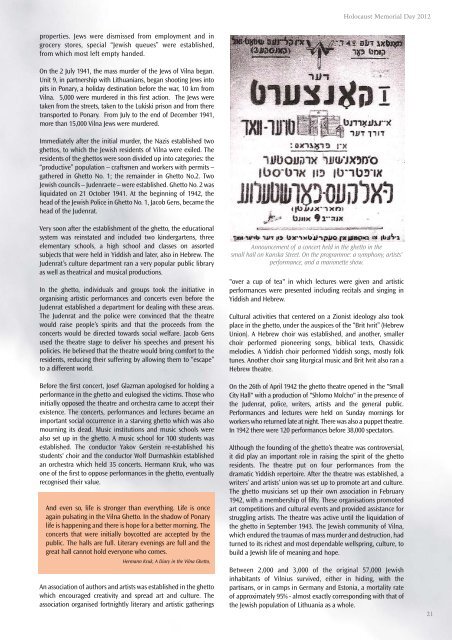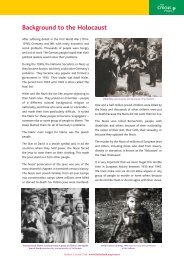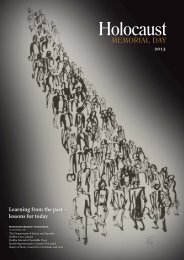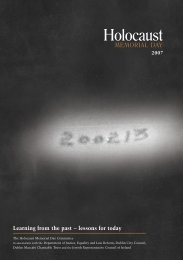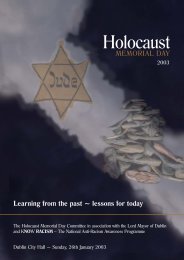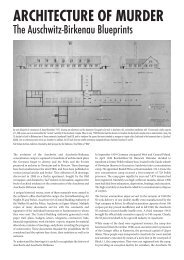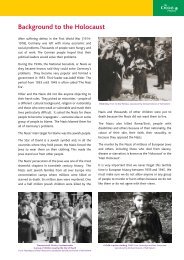Learning from the past ~ lessons for today - Holocaust Education ...
Learning from the past ~ lessons for today - Holocaust Education ...
Learning from the past ~ lessons for today - Holocaust Education ...
You also want an ePaper? Increase the reach of your titles
YUMPU automatically turns print PDFs into web optimized ePapers that Google loves.
<strong>Holocaust</strong> Memorial Day 2012<br />
properties. Jews were dismissed <strong>from</strong> employment and in<br />
grocery stores, special “Jewish queues” were established,<br />
<strong>from</strong> which most left empty handed.<br />
On <strong>the</strong> 2 July 1941, <strong>the</strong> mass murder of <strong>the</strong> Jews of Vilna began.<br />
Unit 9, in partnership with Lithuanians, began shooting Jews into<br />
pits in Ponary, a holiday destination be<strong>for</strong>e <strong>the</strong> war, 10 km <strong>from</strong><br />
Vilna. 5,000 were murdered in this first action. The Jews were<br />
taken <strong>from</strong> <strong>the</strong> streets, taken to <strong>the</strong> Lukiski prison and <strong>from</strong> <strong>the</strong>re<br />
transported to Ponary. From July to <strong>the</strong> end of December 1941,<br />
more than 15,000 Vilna Jews were murdered.<br />
Immediately after <strong>the</strong> initial murder, <strong>the</strong> Nazis established two<br />
ghettos, to which <strong>the</strong> Jewish residents of Vilna were exiled. The<br />
residents of <strong>the</strong> ghettos were soon divided up into categories: <strong>the</strong><br />
“productive” population – craftsmen and workers with permits –<br />
ga<strong>the</strong>red in Ghetto No. 1; <strong>the</strong> remainder in Ghetto No.2. Two<br />
Jewish councils – Judenraete – were established. Ghetto No. 2 was<br />
liquidated on 21 October 1941. At <strong>the</strong> beginning of 1942, <strong>the</strong><br />
head of <strong>the</strong> Jewish Police in Ghetto No. 1, Jacob Gens, became <strong>the</strong><br />
head of <strong>the</strong> Judenrat.<br />
Very soon after <strong>the</strong> establishment of <strong>the</strong> ghetto, <strong>the</strong> educational<br />
system was reinstated and included two kindergartens, three<br />
elementary schools, a high school and classes on assorted<br />
subjects that were held in Yiddish and later, also in Hebrew. The<br />
Judenrat’s culture department ran a very popular public library<br />
as well as <strong>the</strong>atrical and musical productions.<br />
In <strong>the</strong> ghetto, individuals and groups took <strong>the</strong> initiative in<br />
organising artistic per<strong>for</strong>mances and concerts even be<strong>for</strong>e <strong>the</strong><br />
Judenrat established a department <strong>for</strong> dealing with <strong>the</strong>se areas.<br />
The Judenrat and <strong>the</strong> police were convinced that <strong>the</strong> <strong>the</strong>atre<br />
would raise people’s spirits and that <strong>the</strong> proceeds <strong>from</strong> <strong>the</strong><br />
concerts would be directed towards social welfare. Jacob Gens<br />
used <strong>the</strong> <strong>the</strong>atre stage to deliver his speeches and present his<br />
policies. He believed that <strong>the</strong> <strong>the</strong>atre would bring com<strong>for</strong>t to <strong>the</strong><br />
residents, reducing <strong>the</strong>ir suffering by allowing <strong>the</strong>m to “escape”<br />
to a different world.<br />
Be<strong>for</strong>e <strong>the</strong> first concert, Josef Glazman apologised <strong>for</strong> holding a<br />
per<strong>for</strong>mance in <strong>the</strong> ghetto and eulogised <strong>the</strong> victims. Those who<br />
initially opposed <strong>the</strong> <strong>the</strong>atre and orchestra came to accept <strong>the</strong>ir<br />
existence. The concerts, per<strong>for</strong>mances and lectures became an<br />
important social occurrence in a starving ghetto which was also<br />
mourning its dead. Music institutions and music schools were<br />
also set up in <strong>the</strong> ghetto. A music school <strong>for</strong> 100 students was<br />
established. The conductor Yakov Gerstein re-established his<br />
students' choir and <strong>the</strong> conductor Wolf Durmashkin established<br />
an orchestra which held 35 concerts. Hermann Kruk, who was<br />
one of <strong>the</strong> first to oppose per<strong>for</strong>mances in <strong>the</strong> ghetto, eventually<br />
recognised <strong>the</strong>ir value.<br />
And even so, life is stronger than everything. Life is once<br />
again pulsating in <strong>the</strong> Vilna Ghetto. In <strong>the</strong> shadow of Ponary<br />
life is happening and <strong>the</strong>re is hope <strong>for</strong> a better morning. The<br />
concerts that were initially boycotted are accepted by <strong>the</strong><br />
public. The halls are full. Literary evenings are full and <strong>the</strong><br />
great hall cannot hold everyone who comes.<br />
Hermann Kruk, A Diary in <strong>the</strong> Vilna Ghetto,<br />
An association of authors and artists was established in <strong>the</strong> ghetto<br />
which encouraged creativity and spread art and culture. The<br />
association organised <strong>for</strong>tnightly literary and artistic ga<strong>the</strong>rings<br />
Announcement of a concert held in <strong>the</strong> ghetto in <strong>the</strong><br />
small hall on Kanska Street. On <strong>the</strong> programme: a symphony, artists'<br />
per<strong>for</strong>mance, and a marionette show.<br />
"over a cup of tea" in which lectures were given and artistic<br />
per<strong>for</strong>mances were presented including recitals and singing in<br />
Yiddish and Hebrew.<br />
Cultural activities that centered on a Zionist ideology also took<br />
place in <strong>the</strong> ghetto, under <strong>the</strong> auspices of <strong>the</strong> “Brit Ivrit” (Hebrew<br />
Union). A Hebrew choir was established, and ano<strong>the</strong>r, smaller<br />
choir per<strong>for</strong>med pioneering songs, biblical texts, Chassidic<br />
melodies. A Yiddish choir per<strong>for</strong>med Yiddish songs, mostly folk<br />
tunes. Ano<strong>the</strong>r choir sang liturgical music and Brit Ivrit also ran a<br />
Hebrew <strong>the</strong>atre.<br />
On <strong>the</strong> 26th of April 1942 <strong>the</strong> ghetto <strong>the</strong>atre opened in <strong>the</strong> "Small<br />
City Hall" with a production of "Shlomo Molcho" in <strong>the</strong> presence of<br />
<strong>the</strong> Judenrat, police, writers, artists and <strong>the</strong> general public.<br />
Per<strong>for</strong>mances and lectures were held on Sunday mornings <strong>for</strong><br />
workers who returned late at night. There was also a puppet <strong>the</strong>atre.<br />
In 1942 <strong>the</strong>re were 120 per<strong>for</strong>mances be<strong>for</strong>e 38,000 spectators.<br />
Although <strong>the</strong> founding of <strong>the</strong> ghetto’s <strong>the</strong>atre was controversial,<br />
it did play an important role in raising <strong>the</strong> spirit of <strong>the</strong> ghetto<br />
residents. The <strong>the</strong>atre put on four per<strong>for</strong>mances <strong>from</strong> <strong>the</strong><br />
dramatic Yiddish repertoire. After <strong>the</strong> <strong>the</strong>atre was established, a<br />
writers’ and artists’ union was set up to promote art and culture.<br />
The ghetto musicians set up <strong>the</strong>ir own association in February<br />
1942, with a membership of fifty. These organisations promoted<br />
art competitions and cultural events and provided assistance <strong>for</strong><br />
struggling artists. The <strong>the</strong>atre was active until <strong>the</strong> liquidation of<br />
<strong>the</strong> ghetto in September 1943. The Jewish community of Vilna,<br />
which endured <strong>the</strong> traumas of mass murder and destruction, had<br />
turned to its richest and most dependable wellspring, culture, to<br />
build a Jewish life of meaning and hope.<br />
Between 2,000 and 3,000 of <strong>the</strong> original 57,000 Jewish<br />
inhabitants of Vilnius survived, ei<strong>the</strong>r in hiding, with <strong>the</strong><br />
partisans, or in camps in Germany and Estonia, a mortality rate<br />
of approximately 95% - almost exactly corresponding with that of<br />
<strong>the</strong> Jewish population of Lithuania as a whole.<br />
21


